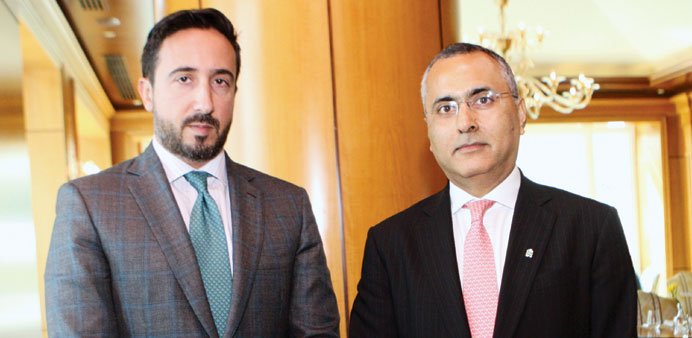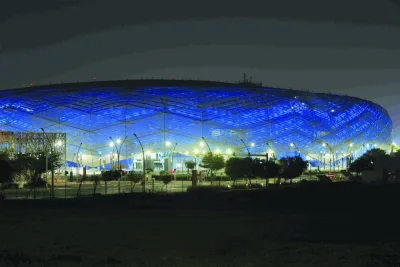Standard Chartered chief economist Marios Maratheftis (left) and head of Corporate & Institutional Clients and Financial Markets Rajat Sapra. PICTURE: Nassar T K
By Peter Alagos
Business Reporter
Driven by mega infrastructure projects related to the 2022 FIFA World Cup and Qatar National Vision 2030, Qatar’s economy is expected to grow “by a solid 5.4% in 2015,” a Standard Chartered report has said.
The report places its economic outlook for Qatar at the high-end of the bank’s growth forecasts for Gulf Co-operation Council (GCC) countries. Government investment in Qatar’s numerous long-term projects… is driving growth, it added.
Citing government forecasts, the report said Qatar’s population could rise to 3.8mn by 2030 from around 2mn currently. The report said population growth is a key driver of Qatar’s long-term infrastructure investment.
“We estimate that almost $27bn worth of projects were awarded in 2014 for key infrastructure projects. We expect project spending to reach $34bn in 2015. A robust project market in Qatar and comfortable fiscal dynamics should allow the government to spend within its means,” Standard Chartered said.
It added that the global slump in liquefied natural gas (LNG) prices is starting to affect the long-term outlook for Qatar’s LNG sector.
Speaking to Gulf Times yesterday, chief economist Marios Maratheftis said: “We’ve seen GCC countries, including Qatar, using the budget to absorb some of the shock from low oil prices. It’s the right thing to do.”
“We’re going to see fiscal deficits in Saudi Arabia and Abu Dhabi. However, I think Qatar will still manage a fiscal surplus but the point I want to make is that a fiscal surplus should not be a target or a goal or an objective.
“If Qatar needs to run a deficit, so be it. It’s been running surpluses for a very long time. We don’t forecast a deficit but a deficit should not be a taboo. We’ve seen throughout the region that governments have been using savings to fund spending, which is the right thing to do. But inevitably that leads to some declines in deposits with banks, which would probably lead to some tightening of liquidity in the region, including Qatar,” he explained.
Maratheftis also said he expects a rebound in energy prices at around $75 per barrel in the fourth quarter of 2016.
“We’re more aggressive because when we estimate the excess supply in the market in the third quarter of this year, it was only at 0.3mn barrels per day. It was 1.6mn bpd in the second quarter of this year,” he said.
Asked about non-oil activity, Maratheftis said: “Inevitably non-oil and gas activity will be the dominant theme in Qatar for the next few years. I agree with the point that it’s mostly non-oil and non-gas growth. There is an indirect impact of oil and gas because they affect revenues, and revenues affect non-oil activity.
“But the direct impact of non-oil and gas is very limited to GDP growth. The direct impact of non-oil activity is dominantly driving growth in Qatar but let’s also make sure that we appreciate the fact that a lot of the non-oil activity depends on oil revenues.”
Mratheftis said the bank puts Qatar’s real GDP at 4.5% in 2016 and around 5% next year “because liquidity will be drying up slightly.”
“We expect higher oil prices but we see that towards the end of the year. The positive impact of higher oil prices will be felt in 2017,” he added.
Head of Corporate & Institutional Clients and Financial Markets Rajat Sapra said from the international markets point of view, Qatar “is a much better place” because of high credit ratings.


